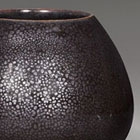J.J. Lally & Co., Oriental Art / New York City, New York
MenuPast Exhibition
Chinese Ceramics in Black and White
March 20–April 10, 2010
25.
AN ‘OIL SPOT’-GLAZED STONEWARE LOTUS-BUD FORM JAR
Song Dynasty (A.D. 960–1279)
with deep rounded sides tapering to a wide mouth with gently incurved lipless rim and resting on a short footring with straight sides, covered inside and out with a lustrous very dark brown-black glaze thinning to chocolate-brown at the edge of the mouth and adorned with small silvery ‘oil spot’ markings all over, the glaze ending low on the sides, the steeply rounded underside, foot ring and shallow recessed base coated with black slip.
Height 35⁄8 inches (9.2 cm)
A lotus-bud form stoneware jar of very similar shape covered with a dark olive-brown glaze from the Barron Collection is illustrated by Rotondo-McCord in Heaven and Earth Seen Within, New Orleans, 2000, p. 102, no. 36.
An ‘oil spot’-glazed stoneware lotus-bud form jar of more tapered form is illustrated by McElney in The Museum of East Asian Art Inaugural Exhibition, Vol. I, Chinese Ceramics, Bath, 1993, p. 156, no. 110.
Compare also the Song dynasty lotus-bud form stoneware jar, with plain black glaze, illustrated by Krahl in Chinese Ceramics from the Meiyintang Collection, Volume One, London, 1994, p. 245, no. 443. Another black-glazed bud form jar is illustrated by Gyllensvärd, in Chinese Ceramics in the Carl Kempe Collection, Stockholm, 1964, p. 94, no. 266.
Two small ‘oil spot’-glazed bowls from the Dane Collection in the Harvard University Art Museums are illustrated by Mowry, Hare’s Fur, Tortoiseshell, and Partridge Feathers: Chinese Brown- and Black-Glazed Ceramics, 400–1400, Cambridge, 1996, pp. 148–150, nos. 43 a&b, where the author states that ‘oil spot’-glazed stonewares with black slip covering the unglazed lower body have been found at the Xiaoyu cun kilns at Huairen, Shanxi province and attributed to the 12th century.
宋 黑釉油滴斑蓮子形水盂 高 9.2 厘米
